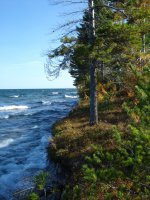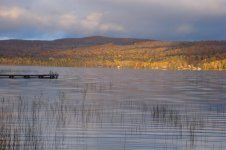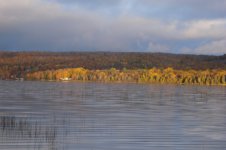You are using an out of date browser. It may not display this or other websites correctly.
You should upgrade or use an alternative browser.
You should upgrade or use an alternative browser.
Western UP fall colors
- Thread starter XTEAM
- Start date
Here is a satellite view of the UP. You can really see the color change.
https://coastwatch.glerl.noaa.gov/m...image=a1.19282.1900.LakeSuperior.143.250m.jpg
https://coastwatch.glerl.noaa.gov/m...image=a1.19282.1900.LakeSuperior.143.250m.jpg
Foliage Network's Midwest report for October 10
From (click →) The Foliage Network! | Foliage Reports, as of today (October 10, 2019)
Wisconsin's Northern Highlands and from ≈Ironwood to ≈Iron Mountain, MI and north through much of the Huron Mountains is now at Peak Color, with Houghton and Keweenaw counties and the eastern UP still hanging in with Moderate Color.
Leaf Drop from LaCrosse through Wisconsin's Northern Highlands to ≈Iron Mountain and all of the UP is reported as still Moderate.
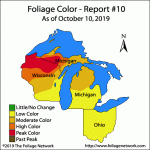
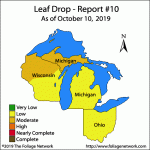
From (click →) The Foliage Network! | Foliage Reports, as of today (October 10, 2019)
Wisconsin's Northern Highlands and from ≈Ironwood to ≈Iron Mountain, MI and north through much of the Huron Mountains is now at Peak Color, with Houghton and Keweenaw counties and the eastern UP still hanging in with Moderate Color.
Leaf Drop from LaCrosse through Wisconsin's Northern Highlands to ≈Iron Mountain and all of the UP is reported as still Moderate.


Last edited:
View attachment 60707 one of the many great shots from the last couple days. It's the most vibrant I have seen the colors in years
Strange what happens when it rains.
Bear
If I had to guess, I'd say it sure looks likeWhich falls is that?
(click →) WikedyPedia: Bond Falls.
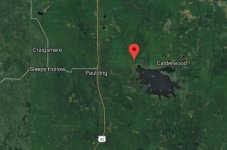
Foliage Network's Midwest report for Monday, October 14
From (click →) The Foliage Network! | Foliage Reports, as of Monday (October 14, 2019)
In spite of the stunning colors in some of the pictures in John's Journal entry of October 13, 2019, "A Dandy" and other posts in this thread, it ain't necessarily over yet:
Wisconsin's Northern Highlands and south of a line from ≈Ironwood through the Huron Mountains, and north of ≈Iron Mountain, MI through Chippewa and Mackinac Counties at eastern end of the UP is all at Peak Color, while Houghton and Keweenaw counties seem to still be hanging in with Moderate Color.
Leaf Drop north of a line from ≈LaCrosse through ≈Green Bay and all of the UP is reported as still Moderate, with areas to the south still showing Low Leaf Drop.

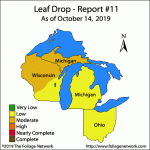
Not very many days left for this year …

She's warming up!
From (click →) The Foliage Network! | Foliage Reports, as of Monday (October 14, 2019)
In spite of the stunning colors in some of the pictures in John's Journal entry of October 13, 2019, "A Dandy" and other posts in this thread, it ain't necessarily over yet:
Wisconsin's Northern Highlands and south of a line from ≈Ironwood through the Huron Mountains, and north of ≈Iron Mountain, MI through Chippewa and Mackinac Counties at eastern end of the UP is all at Peak Color, while Houghton and Keweenaw counties seem to still be hanging in with Moderate Color.
Leaf Drop north of a line from ≈LaCrosse through ≈Green Bay and all of the UP is reported as still Moderate, with areas to the south still showing Low Leaf Drop.


Not very many days left for this year …

She's warming up!
Which falls is that?
Yep its the Bond falls. I would like to be there sometime when the alarm goes off!! LOL. The power company I believe (frnash???) spent most of the money building that park. The steps along the south side are pretty neat. Get up close to the action!! Can you guess where this is?

Last edited:
Yes, that was done by Upper Peninsula Power Company (UPPCO).Yep its the Bond falls. I would like to be there sometime when the alarm goes off!! LOL. The power company I believe (frnash???) spent most of the money building that park. The steps along the south side are pretty neat. Get up close to the action!!
Unless I’ve been away far too long, that’s the iconic view of the (click →) Wikedypedia: Lake of the Clouds, from the Lake of the Clouds Overlook at the west terminus of the former Michigan Highway M-107 in the Porcupine Mountains.Can you guess where this is? View attachment 60723
sweeperguy
Active member
Eastern UP colors are top shelf this year also
More about Bond Falls and UPPCO (circa 2002-2009).
More about Bond Falls and UPPCO (circa 2002-2009); It took a bit of searching to find this citation:
UPPCO sold its “non-project lands” around these reservoirs in December, 2005 to Naterra Land, a Minnesota-based Realty firm. Naterra then quickly announced plans to subdivide the non-project lands into lots for hundreds of residential homes. The SMP proposal outlined UPPCO’s plans to develop the FERC project lands closest to the reservoirs by building lighted docks, paths from the homes to the water, marina facilities, and other amenities primarily designed to benefit the adjacent homeowners.
In 2009 UPPCO bought back substantial acreage from Naterra to settle a breach of contract lawsuit in which the latter company alleged UPPCO had not provided accurate information about easements, pier placements, and future dam repairs.
See (click →) UP Environment, (the quarterly newsletter of the …
(click →) Upper Peninsula Environmental Coalition)
FALL 2011, quoted here in part:
More about Bond Falls and UPPCO (circa 2002-2009); It took a bit of searching to find this citation:
UPPCO sold its “non-project lands” around these reservoirs in December, 2005 to Naterra Land, a Minnesota-based Realty firm. Naterra then quickly announced plans to subdivide the non-project lands into lots for hundreds of residential homes. The SMP proposal outlined UPPCO’s plans to develop the FERC project lands closest to the reservoirs by building lighted docks, paths from the homes to the water, marina facilities, and other amenities primarily designed to benefit the adjacent homeowners.
In 2009 UPPCO bought back substantial acreage from Naterra to settle a breach of contract lawsuit in which the latter company alleged UPPCO had not provided accurate information about easements, pier placements, and future dam repairs.
See (click →) UP Environment, (the quarterly newsletter of the …
(click →) Upper Peninsula Environmental Coalition)
FALL 2011, quoted here in part:
UPPCO withdraws shoreline management plans for Bond Falls, Prickett & Boney Falls
By Robert Evans
The Upper Peninsula Power Company (UPPCO, an Integrys Energy Group subsidiary) recently withdrew its proposed Shoreline Management Plans (SMPs) nearly four years after submitting them to the Federal Energy Regulatory Com-mission (FERC). The SMPs involved UPPCO’s hydroelectric project lands surrounding reservoirs on the Ontonagon, Sturgeon, and Escanaba Rivers.In its July 25 letter to the FERC secretary, UPPCO requested that the SMPs be withdrawn “because the plans are no longer pertinent to our current business model for excess lands.” There was no press release from UPPCO about the SMP withdrawal, nor is there any information about it posted on UPPCO’s website.FERC’s acceptance of the SMPs would have allowed infrastructure developments on environmentally sensitive project lands that could have enhanced and added financial value to potential residential developments on non-project lands that are outside of FERC regulation. If each reservoir is visualized as the inner-most of three concentric circles, the project lands are the next circle starting at the shoreline, and the non-project lands are the outermost circle.
Clear FERC ruling would have been helpful for preventing future shoreline threats
Reservoirs. . . . . . . . . . . .Continued from Page 1
UPPCO’s withdrawal of its SMPs hopefully concludes an ordeal that began in 2002 when it announced an “asset management strategy” for its Upper Peninsula lands. In that strategy, lands “not needed for hydroelectric boundaries that lay outside project boundaries” would be targeted for sale. For most of its hydroelectric projects, including these three, UPPCO-owned lands near the reservoirs included a mix of both project and non-project lands. FERC requires that project lands be managed to provide both public benefits (such as recreation) as well as habitat for wildlife, in exchange for allowing the utility to utilize a public water resource to produce hydroelectric power.
UPPCO sold its “non-project lands” around these reservoirs in December, 2005 to Naterra Land, a Minnesota-based Realty firm. Naterra then quickly announced plans to subdivide the non-project lands into lots for hundreds of residential homes. The SMP proposal outlined UPPCO’s plans to develop the FERC project lands closest to the reservoirs by building lighted docks, paths from the homes to the water, marina facilities, and other amenities primarily designed to benefit the adjacent homeowners. In 2009 UPPCO bought back substantial acreage from Naterra to settle a breach of contract lawsuit in which the latter company alleged UPPCO had not provided accurate information about easements, pier placements, and future dam repairs.
UPPCO’s proposal to FERC to develop the project lands met with immediate and strong opposition from a coalition of natural resource agencies (U.S. Forest Service, U.S. Fish and Wildlife Agency, Michigan DNR) as well as environmental organizations such as the Michigan Hydro Relicensing Coalition, Upper Peninsula Public Access Coalition, the Northwoods Alliance, the Friends of the Land of Keweenaw, and UPEC. These agencies and organizations urged FERC to reject the SMPs on the grounds that UPPCO’s proposed land development was inconsistent with FERC license requirements that project lands be managed to benefit the public and natural resources such as wildlife, including threatened and endangered species.
Although UPPCO withdrew its SMPs, FERC never rejected them. Without a FERC ruling, we don’t know at this point whether arguments put forth by the resource agencies and environmental organizations would have persuaded FERC to kill UPPCO’s ill-advised plans to profit from developing land intended for public benefit and natural resource protection.For the time being, however, UPPCO’s decision represents good news for the environment and good news for anyone who believes that a utility that profits from public resources (water, in this case) must abide by the terms of its regulatory license.
Foliage Network's Midwest report for Thursday, October 17
From (click →) The Foliage Network! | Foliage Reports, as of late Thursday (October 17, 2019)
For much of Wisconsin north of a line from ≈LaCrosse through ≈Green Bay and all of the UP, the color was finally reported at Full Peak today, with just a small section of Wisconsin's Northern Highlands now Past Peak.
Pretty much all of the same area is now showing Leaf Drop as Moderate, with with the same small section of Wisconsin's Northern Highlands now with High Leaf Drop.
I hope we'll see stunning photos posted here of this Peak Color in the few remaining days before the show is all over for the year.
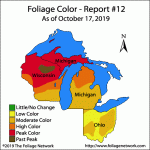
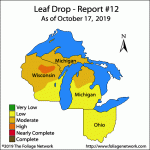
From (click →) The Foliage Network! | Foliage Reports, as of late Thursday (October 17, 2019)
For much of Wisconsin north of a line from ≈LaCrosse through ≈Green Bay and all of the UP, the color was finally reported at Full Peak today, with just a small section of Wisconsin's Northern Highlands now Past Peak.
Pretty much all of the same area is now showing Leaf Drop as Moderate, with with the same small section of Wisconsin's Northern Highlands now with High Leaf Drop.
I hope we'll see stunning photos posted here of this Peak Color in the few remaining days before the show is all over for the year.



